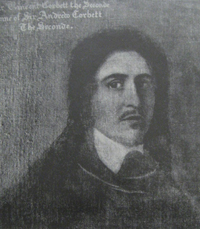
Corbet Close is one of the cul-de-sacs off Little Harlescott Lane, in north Shrewsbury. It commemorates the Corbet family, who have been influential in Shropshire since the Norman Conquest. Roger FitzCorbet is thought to have fought for the Normans at the Battle of Hastings, and so was rewarded with manors in Shropshire, the most important being Caus Castle, which he named after his Normandy estate in the Pays de Caux. [footnote 1] Corbets then spread out from there to other parts of Shropshire – in 1239 one branch inherited what became Moreton Corbet Castle, near Shawbury. In the late 16th century the Corbets added a large and beautiful range of buildings to this medieval castle. [footnote 2] The Corbet family crest is a crow, derived from the old French ‘corbet’, which means crow. To this the Moreton Corbet family added an elephant and castle, traditionally a double symbol of strength. These are preserved in pub names and signs – the Corbet Arms in both Uffington and Upton Magna, and the Elephant and Castle in Shawbury.
The English Civil War resulted in a sharp downturn in the family’s fortunes. Sir Vincent Corbet (1617 – 56) was a staunch Royalist, as were most of the Shropshire gentry. [footnote 3] Sir Vincent garrisoned Moreton Corbet Castle for the king, and took an active role in the Royalist army, commanding a regiment of horse and foot raised by the gentry and clergy of Shropshire. [footnote 4] Sir Vincent, though a brave and committed commander, was defeated on several occasions in minor battles in and around Shropshire. He also led the Shrewsbury foot at the Battle of Naseby in June 1645, when the Royalists were heavily defeated.

Prior to that, in September 1644, Moreton Corbet Castle was captured by the Parliamentarians, with only about a dozen men. [footnote 5] Under cover of darkness, they made out they had a large force by using drums to simulate the sound of marching, and shouting orders to non-existent reinforcements. Two soldiers then distracted a sentry, while others used ladders to scale a wall. When the Royalists retreated into the main house, the Parliamentarians threw in hand grenades and entered by breaking a window. Thoroughly rattled, the Royalists surrendered, and the Parliamentarians were amazed to find that they had captured 6 officers and NCOs, 80 soldiers, 30 horses and six barrels of gunpowder!
Sir Vincent Corbet was not there, however, and he continued fighting until he was captured at the surrender of Bridgnorth Castle in April 1646. The defenders were allowed to leave with just their swords and colours, and had to live at least 40 miles away for two months, when they had to either make peace with Parliament or go into exile. [footnote 6] Sir Vincent chose the former, and he and his family lived in London until the restoration of the king. [footnote 7] At the end of the war he had to pay a large fine, with a further smaller sum annually. [footnote 8] To pay for this the family had to sell many of their estates, including some in Shropshire. [footnote 9]

Moreton Corbet Castle was garrisoned by Parliament until the end of the Civil War, when its fortifications were destroyed. Sir Vincent Corbet had to sell the house to help pay his fines, but it was bought back by his descendant Andrew Corbet in 1743. However, the plans he had for its reconstruction were never carried out. [footnote 10] By then the family was based at Shawbury Park (demolished in the 19th century); later they moved to Acton Reynald Hall, and now live at Preston Hall, Preston Brockhurst. [footnote 11] Moreton Corbet Castle is managed by English Heritage. It is open all year with free admission, and can be found just beyond RAF Shawbury. Further details can be found here.
A rare survival from the Castle is the Corbet bed dating from 1593, which is on long term loan to Shrewsbury Museum from the Victoria and Albert Museum. Its hangings have been wonderfully recreated by a team led by Leila Corbet and Margaret Owen, and it is well worth a visit. If you cannot visit, pictures can be viewed online here.
Footnotes
[1] Wikipedia – Caus Castle and Corbet family – accessed December 2012
[2] Information board at the Castle
[3] The Family of Corbet, by AEC, 1915, Vol. 2, p321ff (copy at SA qBC78)
[4] Terry Bracher and Roger Emmett, Shropshire in the Civil War, Shropshire Books, 2000, p.21
[5] The Family of Corbet,, Vol. 2, p.335-6
[6] Ibid, p.337
[7] Ibid, p.339
[8] The Family of Corbet, p.339; and http://www.melocki.org.uk/salop/MoretonCorbet.html#top state that the fine was £1588 and £80 a year. Bracher and Emmet give the figure as £2,822. These approximate to £¼-½m as a one-off and £10,000 a year.
[9] Richard Gough, The History of Myddle, Penguin Edition 1981, p.164, gives one example
[10] Peter and Anne Duckers, Castles of Shropshire, Tempus, 2006, p.119
[11] Christopher Corbet, personal communication; Preston Hall was built by the Wingfield family in 1652 when they bought the estate from Sir Vincent Corbet after the Civil War (Gough, p.164). It was later bought back by the Corbets.
